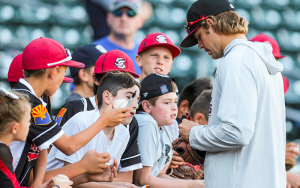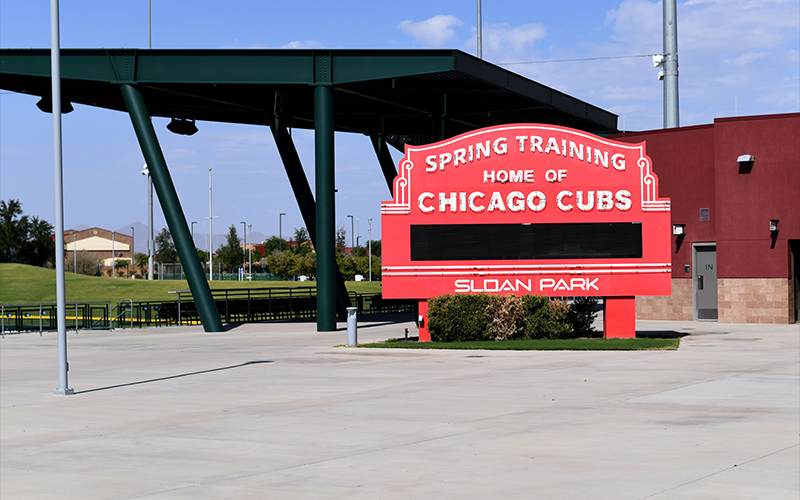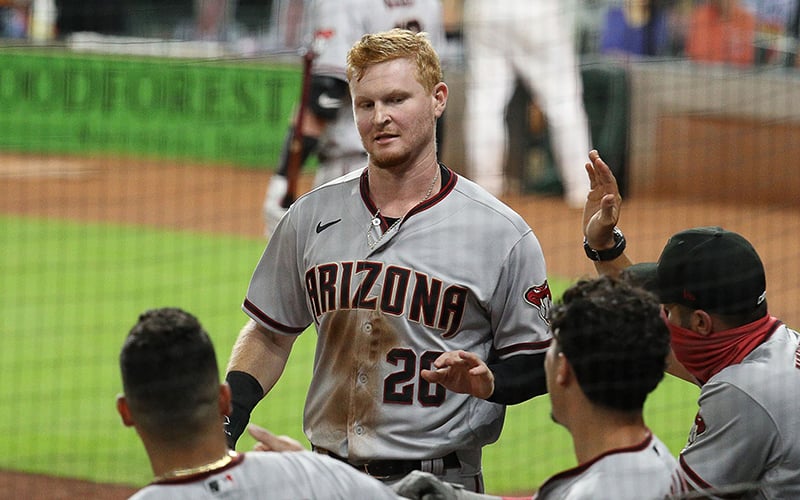PHOENIX – News of MLB’s decision to cancel the 2020 Arizona Fall League season left some players reminiscing on how the experience shaped their bond with the game.
While there had been speculation about the AFL being canceled this year after the 2020 minor league season was scrapped, MLB made its decision official on Monday, citing safety precautions and lack of stadium accommodations as primary reasons.
For those who have experienced what it’s like to compete in the AFL, being without a 2020 season is considered a significant loss.
“Guys are just missing out on that ultimate competition level,” Atlanta Braves prospect Trey Harris said. “For some guys, it exposes some things you need to work on, and for other guys it elevates their game.”
Founded in 1992 as a way to extend the seasons for 180 of MLB’s top prospects, the AFL operates across six ballparks in Scottsdale, Glendale, Mesa, Peoria and Surprise. Each of the 30 MLB clubs sends six of their best young players.
“The competition that the AFL provides is top-notch all across minor league baseball,” sports commentator Dominic Cotroneo said. “You’re facing all of the best. Every inning you can’t take a pitch off.”
With the addition of coaches, trainers and other necessary team staff, along with 180 players, MLB determined the facilities would not be able to accommodate the numbers, let alone adhere to social-distancing requirements in 2020.
At this point, however, MLB expects the AFL to return in 2021.
The Fall League focus
Over the years, the AFL has hosted some of the sport’s most exciting prospects, some of whom are among MLB’s elite in the shortened 2020 season.
Perennial All-Stars like Mike Trout, Nolan Arenado and Mookie Betts have competed in the AFL, as have Hall of Famers as Derek Jeter and Mike Piazza.
Getting the call to report to the Valley is regarded as an honor for young players, as it not only speaks to their development in the minors, but allows for them to compete on an elite stage.
“Everybody’s got goals that they want to accomplish,” Miami Marlins prospect Vincenzo Aiello said. “In the 2019 campaign, mine was definitely (to) prove to Miami and prove to baseball that I deserve a shot.”
Aiello, a right-handed pitcher who last played for the Jacksonville Jumbo Shrimp of the Double-A Southern League, won the 2019 AFL Championship as a member of the Salt River Rafters.
What he remembers most fondly about his experience in the AFL is developing new perspectives and adding to his experience.
“You learn from other guys,” Aiello said. “You learn different routines, different tactics or whatever it might be to get you ready for the game.”
The AFL has existed as a source of growth in many departments for players, whether it be skill, maturity, camaraderie, chemistry or adaptability.
With regards to their level of talent, many players find themselves on neutral ground with their opponents, which creates an extra sense of friendly competition that will likely last for years as they work their way to the top.
“If I really want to be a big leaguer, these are the guys I’m going to have to handle,” Harris said. “For me, it is the opportunity to become more confident in my game because if I can smack these guys, I can smack anyone.”

Although fan attendance was typically small, the Arizona Fall League provided a valuable service to young players such as J.J. Matijevic (right) and MLB teams looking for talent. (Photo by Joshua Sarner/Icon Sportswire via Getty Images)
In past years, competing in Arizona has benefited players off the field as well.
As clusters of players were often housed together, the AFL helped to create new friendships and cultivate a lasting sense of respect.
“My Scorpions team, we’re in a group text and we talk probably twice a week,” Harris said. “Good memories … We would all just kick it at each other’s house until late at night, just hanging out, talking about random stuff, laughing and joking.”
A league of their own
In the AFL, the focus was never about fan attendance and ticket sales. According to MiLB.com, the average attendance at AFL games in 2019 was just 500 fans per game.
While the Fall Stars and Championship games have been known to draw thousands, the AFL has often been viewed as a mecca for scouts and diehards.
“Regardless of how many fans are in the stands for a Fall League game, it is something that people are watching,” said Jacob Pomrenke, director of editorial content for the Society of American Baseball Research. “You’ve got the most talented prospects coming up and these small, intimate environments (where) you can sit anywhere in the park and watch these future stars up close.”
Fans in attendance at games are proven to have immediate effects on player performance, sometimes good, sometimes bad. For players in the AFL, the low fan turnout presents a happy medium: their play is still recognized and revered, but in a setting where they can interact with fans and engage with a community of baseball lovers.
“We (are) literally walking down the side of the field just talking to everybody because there (are) not that many people there,” Harris said. “We just enjoy being able to talk to fans and get to know them.”

Players such as Isaac Mattson signing autographs for young fans following an Arizona Fall League game is not uncommon. The league’s intimidate setting is one of the reasons players speak so highly of it. (Photo by Joshua Sarner/Icon Sportswire via Getty Images)
The silver lining
With COVID-19 restrictions looming over the 2020 season, MLB expanded player pools to 60 players and incorporated alternate training sites across the country for select prospects and minor leaguers.
Many players have reported to these sites and some have earned early call-ups to the Majors, which would have lessened the amount of immediate candidates available for the AFL.
The good news for minor leaguers not selected to report to the alternate training sites, however, is that MLB is still allowing Fall Instructional League ball to take place, which creates opportunities for players in the second echelon of development.
“If you get invited to (instructional ball), the team you are playing for thinks you’re doing something well and they want to make it even better for you,” Cotroneo said. “That’s the ultimate compliment for a minor leaguer – to get that respect.”
Teams must submit a COVID-19 testing and safety plan, and when approved, available minor league players will be able to report either to the alternate training sites or, in some cases, a spring training site for professional competition.
Although there will be no fans in attendance, the Instructional League this year could be preparing for one of its biggest seasons yet, with some teams – like the San Diego Padres – doubling up for a potential 40-game slate.
Most importantly, though, a functioning Fall Instructional League will help fill the void that has been left by the absence of the AFL.
“For young players, getting reps in any way possible is going to be helpful for their development,” Pomrenke said “In-game situations are always going to be helpful for them.”


